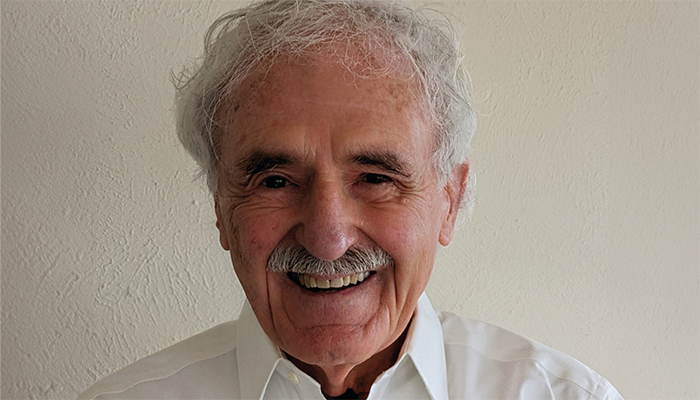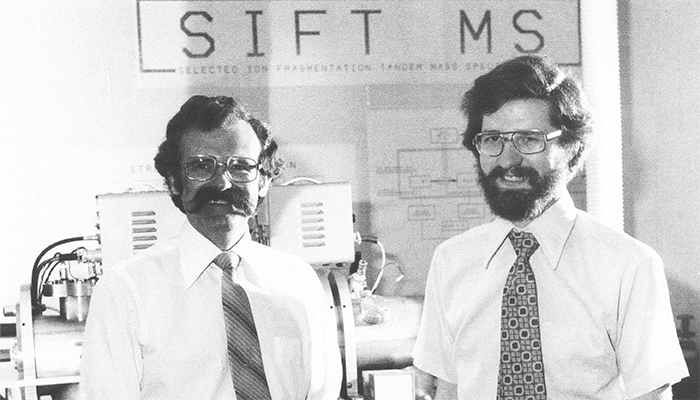
You never know where an after-show dinner with a colleague may lead…
My career wasn’t exactly planned. I always enjoyed science and teaching. But electronics was my first love. I originally attended a liberal arts college and planned to transfer out to get my electrical engineering degree. But I ended up falling in love with chemistry as well. So electrochemistry – using electronics in chemistry – was just perfect for me. But when the top universities had filled their electroanalytical positions and I struggled to find a placement for an excellent graduate student, I decided to move into computers.
I had one of the first laboratory computers, which I used to automate instruments – not just the data collection but also the instrument itself. My reputation in this area grew and I started to think about making an automated analytical instrument. I wanted to have both the separation and identification – or at least certain aspects of both – under computer control.
Rick Yost had just joined my group and chose this project. We were puzzled about what kind of separation method we could use and Rick mentioned this thing called the quadrupole mass spectrometer – which seemed like a good fit. The next question was what to use for identification. Here again, mass spectrometry seemed like a good option. The problem was that we needed to fragment the ions that we had selected to get the characteristic spectrum for identification, which is where we were stuck.
We consulted with Graham Cooks, who was an expert in metastable ion fragmentation found in double-sector mass spectrometers. We outlined our goal of separation, fragmentation, and identification, but we could not come up with an efficient fragmentation method using quadrupole analyzers. Graham, undeterred by the poor efficiency of high energy fragmentation, implemented the concept on his sector instruments and opened up the analytical potential of tandem analyzers.
Looking for inspiration, we went to ASMS in Washington, USA (1977), where we bumped into an old friend of mine, Jim Morrison. Back in his room after a nice dinner, he told us about his experiments with photofragmentation between quadrupole analyzers – which he hadn’t yet published. I thought perhaps we could use photoionization. And he said, no – it's just ridiculously inefficient. In fact, it's so inefficient, he said, that I have to use synchronous demodulation to sort the fragments from the noise. And I said, what noise? You have the second quadrupole to pass only fragment masses, right? I realized that Jim’s noise was the fragmentation process we were looking for!
At the time, nobody believed you could have low energy fragmentation. To figure out what was going on, Rick went to work in Jim’s lab. We eventually proved that there was low energy fragmentation, it’s just that the fragments scattered. And because Jim had a third quadrupole set to pass all ion masses, between his selector and analyzer, the scattered ions weren’t disappearing into the pumps. That was the key breakthrough that led to the development of the triple quadrupole mass spectrometer. Jim was a co-inventor on the low-energy fragmentation patent.

Never underestimate serendipity; but you still have to persist in the face of skepticism
I’ve always thought that you have to throw some balls in the air and some you catch and some you don’t. I’ve had plenty of ideas that don’t work. And with the triple quadrupole, there was so much serendipity – Rick having suggested quadrupoles, our informal chat with Jim Morrison, the funding…
We faced a lot of skepticism. Really, we had no experience (we weren’t mass spectrometrists!) and no equipment. And even when we published the paper with Jim Morrison on low energy fragmentation, we still didn’t know completely what was going on. In fact, some tried to prevent the paper from being published.
And prior to meeting Jim, we’d submitted many proposals, and basically, we were told: you’re nuts, it’ll never work, and who are you anyway? We ended up getting funding from an unusual place: the Office of Naval Research. They weren’t interested in the mass spectrometry. But I had realized that our lab computer wasn’t fast enough to control all aspects of running a mass spec – especially scanning and detecting. So I had the idea of incorporating a network of microprocessors that had just come on the market (I called the idea “distributed intelligence”). This was the aspect of the project that hooked in the Office of Naval Research. If it wasn’t for that, I don’t think we’d have ever gotten funding. But we persevered – and the rest is history.
Follow the problems
Some scientists are motivated by the possibility of having a real-world impact. For me, I’m not sure exactly how it happens, I find myself thinking about problems that I might be able to solve, which often opens up new avenues and further problems. In fact, I’m still thinking about some of the problems that arose from our work back in the 1970s.
For example, after we invented the triple quad, I got interested in time-of-flight because I thought it could help solve some of the problems associated with generating a full three-dimensional map from the triple quad. But then I realized there’s a detection problem with time-of-flight – achieving adequate ion focusing to generate meaningful results. As a result, the early TOF-MS instruments were displaced by quadrupole analyzers. This problem has been addressed with modern electronics, pulsing schemes, and ion-beam collimation techniques. We developed a tandem TOF instrument using photo fragmentation. But I started working on an alternative solution: distance-of-flight mass spectrometry (DOF-MS).
In DOF, ions of different mass-to-charge (m/z) are separated by the distance they travel in a given time after acceleration, where different methods of ion focusing and detection are used. DOF-MS can provide wider dynamic range and increased throughput, compared with TOF-MS. In fact, DOF-MS might help us to achieve simultaneous MS/MS – which people have been trying to do for a long time.
I’m still working with Steve Ray, State University of New York at Buffalo, USA, on the challenge of inexpensively achieving the thousands of simultaneous detectors required. Intrigued by its application to complex mixture analysis, I looked into the way component responses of complex mixtures were distributed. This work involved Luc Nagels in Belgium and Alex Gundlach-Graham. My paper on Using the Response Distribution to Compare and Optimize Untargeted Analysis Techniques has recently been accepted by the Journal of the American Society of Mass Spectrometry (1).
I think innovation comes from imagination. And imagination is wondering why – and using all of your background, resources, and experience you have to answer your question. And, in fact, my philosophical work tells me that there isn’t one answer to why a particular law works. Just because an explanation makes sense, doesn’t mean it is necessarily correct. And when you think about it, it’s our explanations, not our laws or observations that end up getting changed…
Think about how you know what you know – and don’t become obsolete!
Perhaps the most fundamental problem in science is the question of whether our best scientific theories are, in fact, true, which is of course a philosophical question. In the philosophy literature, some say that Einstein trashed Newton – he proved that Newton was wrong. But if Einstein proved Newton wrong, who’s to say someone won’t prove Einstein wrong. And if Einstein might be wrong, how can we know whether any of our best theories are true? But the fact remains: we teach mechanics the way we do because Newton’s laws work perfectly – when applied to the right problems. Einstein simply proved that Newton didn’t test his equations on objects moving at nearly the speed of light. There are all sorts of laws that have exceptions, and my view is that we can trust laws when applied appropriately. Where there are exceptions, that points towards the existence of new laws, which we can discover.
This is all quite abstract – I blog about this, if you’d like to learn more – but I wish I’d have known about this stuff when I was teaching undergraduates. Our education systems focus on producing students that are able to memorize facts – which they’ll often forget later – and pass exams. We have 800-page textbooks for a single course at university. Is this working? Often, when someone teaches a chemistry course, they have to try to convince students that it will eventually get interesting. I think we’d be better off focusing on the exceptions to rules – where laws don’t apply. Doing so informs students about the law itself, inferences to its application, and points to future opportunities for further study and greater understanding. We should be creating chains of meaning, where students are able to connect what they’re learning to real life – to potential applications and exceptions where the rules they’re taught no longer apply. This is how we produce students that will carry what they’ve learned with them and use it later.
There’s also a lot of skepticism about science today. But I don’t think the response to that is to be dogmatic – to simply present the skeptic with an alternative set of facts that they must believe uncritically. Science itself is driven by skepticism. Explanations are, by and large, tentative analogies – and scientists themselves shouldn’t become dogmatically attached to them. And sometimes, the best ideas come from outside of an echo chamber (I recall, again, the pushback we had on the idea of low-energy fragmentation).
In general, I think that we’ve become too overspecialized in science. Every bit of experience that a person has adds to their potential to imagine other things, and relate those to other things. All of our explanations relate to our experience – and the richer our experience, the more imaginative and creative we can be. By overspecializing, you risk becoming obsolete in 10 years. I’ve had at least three (possibly four) careers. During that time, I’ve seen entire fields become played out, where the innovative period passes away and people get stuck. You can avoid that by stepping outside your comfort zone.
Of course, every job has parts you like better than others. When the parts you’re not appreciating exceed those you are appreciating it’s time to retire – or change fields.
Listen to your students!
All of the students and postdocs I’ve had over the years have influenced my thinking and research direction. I’ve already mentioned the impact Rick Yost had; but I had no interest at all in electrospray ionization before my student Calin Znamirovschi started working in that area – which ended up opening a whole new field for me. Nadja Cech conceived the experiment that demonstrated the relationship between response factor and surface activity in ESI. And early in the triple quadrupole days, I had a student who said we really ought to be working on a way to analyze proteins. There wasn’t any mechanism for doing that at the time, but he was absolutely right.
I’ve had some wonderful students over the years – 69 people did their PhDs with me. Many have gone on to have great careers in academia, industry, teaching, and elsewhere. They all brought something unique. So if there’s one final piece of advice I’d like to offer, it would be: listen to your students!
Credit: Supplied by Interviewee
References
- Christie Enke, “Using the Response Distribution to Compare and Optimize Untargeted Analysis Techniques,” J Am Soc Mass Spectrom (2024). DOI: 10.1021/jasms.4c00272.




